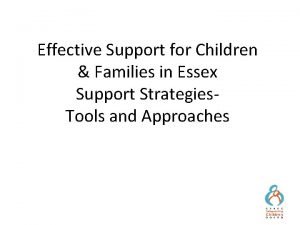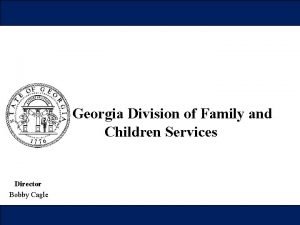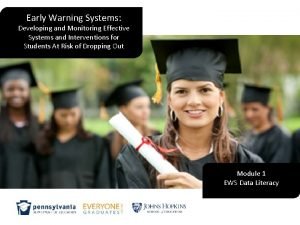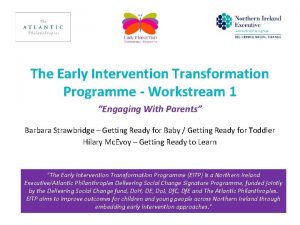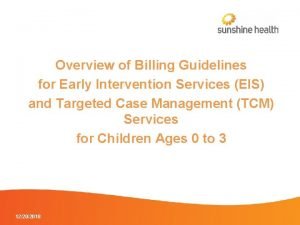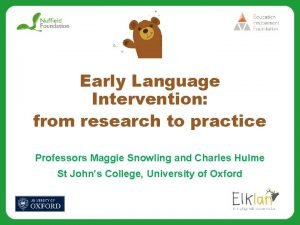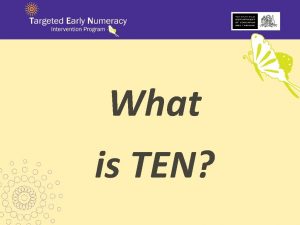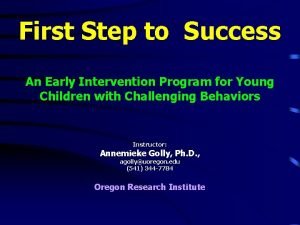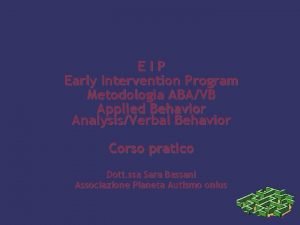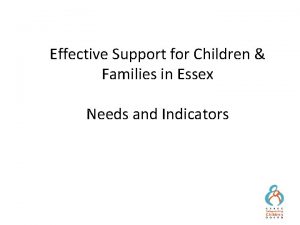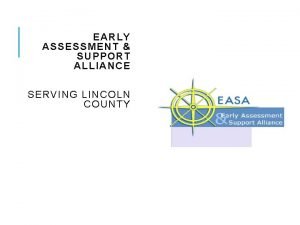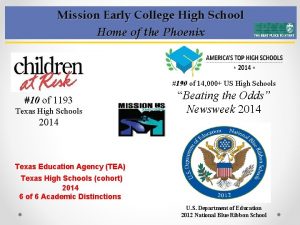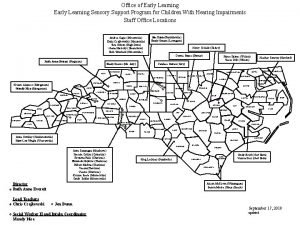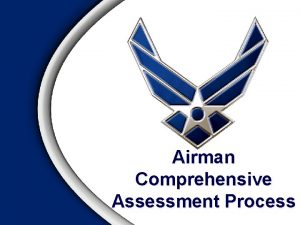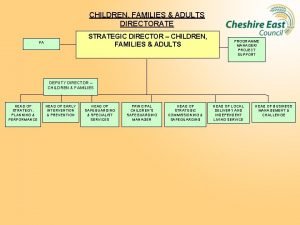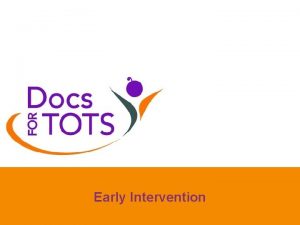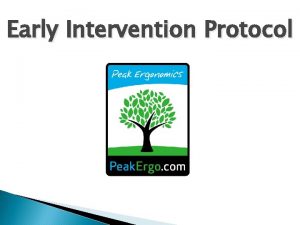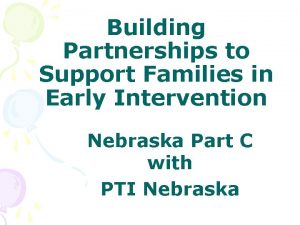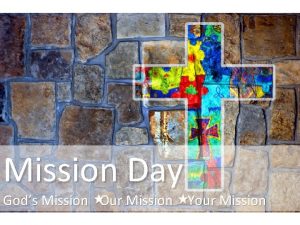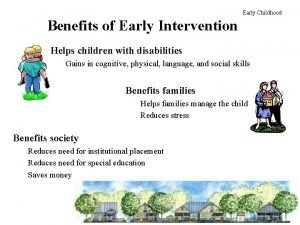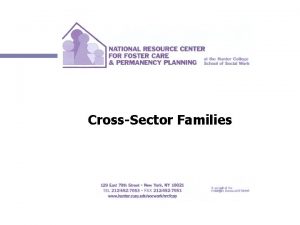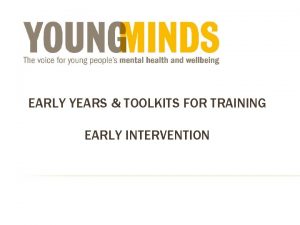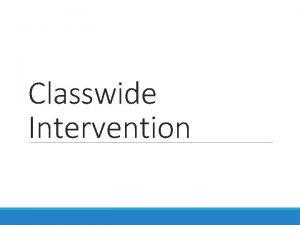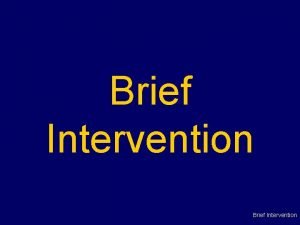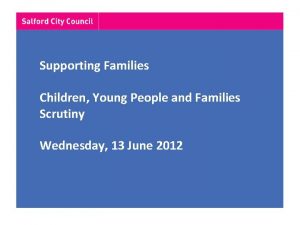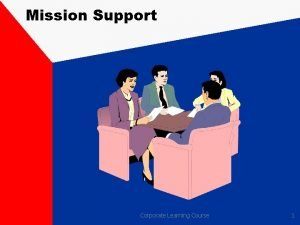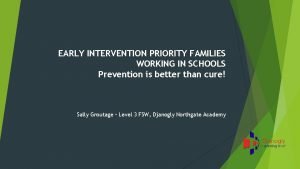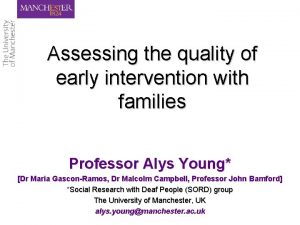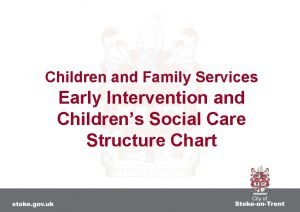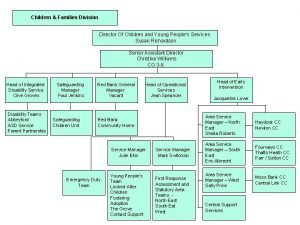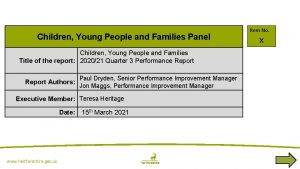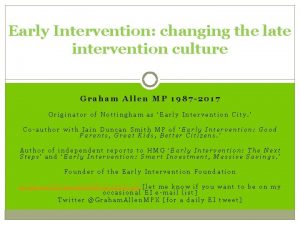Early Intervention Support for Children and Families Mission
























- Slides: 24

Early Intervention Support for Children and Families

Mission of Early Intervention Services Part C early intervention builds upon and provides supports and resources to assist family members and caregivers to enhance children’s learning and development through everyday learning opportunities. Mission and Key Principles of Early Intervention Services http: //www. nectac. org/~pdfs/topics/families/Finalmissionandprinciples 3_11_08. pdf 4 Seven Key Principles Looks Like/Doesn’t Look Like http: //www. nectac. org/~pdfs/topics/families/Principles_Looks. Like_Doesnt. Look. Like 3_11_08. pdf

http: //www. helpmegrow. ohio. gov/ http: //dodd. ohio. gov/

County Boards of Developmental Disabilities

Key Principles 1) Infants & toddlers learn best through everyday experiences and interactions with familiar people in familiar contexts. 2) All families, with the necessary supports and resources, can enhance their children’s learning and development. 3) The primary role of a service provider is to work with and support family members and caregivers in children’s lives. 4) The early intervention process, from initial contacts through transition, must be dynamic and individualized to reflect the child’s and family members’ preferences, learning styles and cultural beliefs.

Key Principles (continued) 5) IFSP outcomes must be functional and based on children’s and families’ needs and family-identified priorities. 6) The family’s priorities, needs and interests are addressed most appropriately by a primary provider who represents and receives team and community support. 7) Interventions with young children and family members must be based on explicit principles, validated practices, best available research, and relevant laws and regulations.

Goals of Early Intervention and Early Childhood Special Education For children to enable young children to be active and successful participants during the early childhood years and in the future in a variety of settings – in their homes with their families, in child care, preschool or school programs, and in the community For families to enable families to provide care for their child and have the resources they need to participate in their own desired family and community activities ECO Center, 2005. Retrieved from http: //www. fpg. unc. edu/~eco/assets/pdfs/ECO_Outcomes_4 -13 -05. pdf Slide taken from Developing High Quality, Functional IFSP Outcomes/IPE Goals Training Package. Available at www. nectac. org/ifsp-outcomes-iep-goals/splash. asp.

Key Concepts Supporting the family to help the child vs. teaching the child specific skills § Family-centered practices Building on activity settings and learning opportunities vs. embedding therapy § How children learn: natural learning opportunities Promoting integration of services vs. focusing on disciplines in isolation § How services are delivered Slide taken from Using Evidence in Early Intervention Service Delivery. Cheatham, Bush & Enright, 2008.

How children learn • Naturally occurring learning opportunities • Every day routines and activities • Within family and community life Dunst, C. J. , Bruder, M. B. , Trivette, C. M. , Raab, M. , & Mc. Lean, M. (2001). Natural learning opportunities for infants, toddlers, and preschoolers. Young Exceptional Children, 4(3), 18 -25. (Erratum in Young Exceptional Children, 4(4), 25) 8 Shelden, M. L. , & Rush, D. D. (2001). The ten myths about providing early intervention services in natural environments. Infants & Young Children, 14(1), 1 -13.

Interest-based Learning Children’s interests influence: Participation in activities Level of engagement in activities Amount of practice of new skills Development of new competencies Sense of mastery (Raab, 2005) Slide taken from Developing High Quality, Functional IFSP Outcomes/IPE Goals Training Package. Available at www. nectac. org/ifsp-outcomes-iep-goals/splash. asp.

EI Services: Focus on Participation

The IFSP Process: IFSP Team • Parents • Service Coordinator • Evaluation and Assessment Team Members • Service Providers • Others Integrating Child and Family Outcomes into the Individualized Family Service Plan (IFSP) Process • http: //projects. fpg. unc. edu/~eco/assets/pdfs/IFSP-Outcomes. Flow. Chart. pdf

IFSP Process: Outcomes IFSP Outcomes: “What would your family like to see happen for your child over the next six months? ” Child Outcomes Family Outcomes

Who Has the Greatest Impact on Child’s Development?

Less is More -- Jung, 2003 1 hour Interventionist Supporting Interventionist Child 84 hours 1 hour Interventionist Caregivers Child Supporting Interventionist If the interventionist coaches the caregivers, the child now has significantly more opportunities for intervention each week.

COACHING IS KEY Coaching is an evidence-based adult learning strategy used for talking with parents and other care providers to recognize what they are already doing that works to support child learning and development as well as building upon existing or new ideas.

Transition to Preschool

County Boards of Developmental Disabilities

Ages 6 -15 County Board Determines Eligibility with COEDI: Children’s Ohio Eligibility Determination Instrument

Service Coordination: Once you are eligible for services, your County Board will link you to needed services and supports. A Services and Support Administrator (SSA) will work with you to develop an Individual Service Plan that outlines what types of supports are needed.

Case Management (Service and Support Administration - SSA) Case management is a process to link individuals and families to needed services and supports provided by local county boards of DODD. It may include any or all of the following supports:

v Information, referral and linkage v Eligibility determination and assessment v Individual Service Plan development and revision v Assistance in provider selection and accessing services v Coordination and monitoring of services v Quality assurance of services provided to individuals and families v Crisis intervention

Goals of Early Intervention, Early Childhood Special Education and Supports for Families For children to enable children to be active and successful participants during the early childhood years and in the future in a variety of settings – in their homes with their families, in child care, preschool or school programs, and in the community For families to enable families to provide care for their child and have the resources they need to participate in their own desired family and community activities ECO Center, 2005. Retrieved from http: //www. fpg. unc. edu/~eco/assets/pdfs/ECO_Outcomes_4 -13 -05. pdf Slide taken from Developing High Quality, Functional IFSP Outcomes/IPE Goals Training Package. Available at www. nectac. org/ifsp-outcomes-iep-goals/splash. asp.

 Effective support for children and families in essex
Effective support for children and families in essex Little families
Little families Georgia department of children and families
Georgia department of children and families Early warning intervention and monitoring system
Early warning intervention and monitoring system Early intervention transformation programme
Early intervention transformation programme Po box 3070 farmington mo 63640
Po box 3070 farmington mo 63640 Neli listening rules
Neli listening rules Targeted early numeracy intervention program
Targeted early numeracy intervention program First step early intervention
First step early intervention Eip early intervention program
Eip early intervention program Effective support for families in essex
Effective support for families in essex Early cpr and early defibrillation can: *
Early cpr and early defibrillation can: * Early assessment and support alliance
Early assessment and support alliance Unit 18 assessing children's development support needs p1
Unit 18 assessing children's development support needs p1 Examples of signal words
Examples of signal words Mission early college high school logo
Mission early college high school logo Early learning sensory support program
Early learning sensory support program Air force feedback form
Air force feedback form Iso 22301 utbildning
Iso 22301 utbildning Typiska novell drag
Typiska novell drag Tack för att ni lyssnade bild
Tack för att ni lyssnade bild Vad står k.r.å.k.a.n för
Vad står k.r.å.k.a.n för Varför kallas perioden 1918-1939 för mellankrigstiden?
Varför kallas perioden 1918-1939 för mellankrigstiden? En lathund för arbete med kontinuitetshantering
En lathund för arbete med kontinuitetshantering Kassaregister ideell förening
Kassaregister ideell förening
